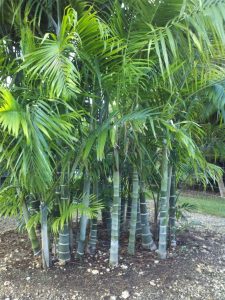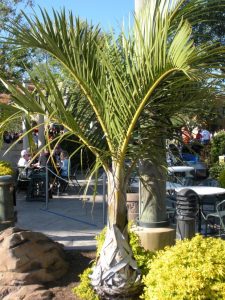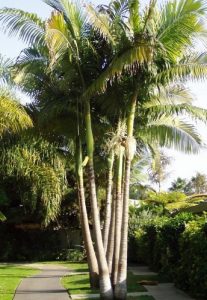Common Palm Tree Species
Butia Capitata
“Jelly Palm”
* Butia capitata, also known as jelly palm, is a palm native to Argentina, Brazil and Uruguay. This palm grows up to 6m in a slow but steady manner.
* Seeds are covered by a fruit-like peel that can be turned into, you guessed it, Jelly!!!!
* An eye-catching and distinctive palm readily recognised by its stout woody trunk and graceful bluish green fronds, makes an attractive specimen plant.
* Moderately slow growing and requires a sunny position
* The Butia is a very hardy palm and will tolerate severe frost, wind and even fairly dry conditions.
* Mature height +-6m
* Relatively slow rate of growth
* Moderate – High salt tolerance

Cocos Nucifera
“Coconut Palm”
* The coconut tree is a member of the family Arecaceae and the only species of the genus Cocos. The term coconut can refer to the whole coconut palm or the seed, or the fruit, which, botanically, is a drupe, not a nut.
* The grey trunks grows to 30m in height, usually with an enlarged base
* Coconuts make an excellent street tree (although plants tend to lean) and are widely planted in the gardens of the sub-tropics.
* Coconuts are most attractive palms for single and group planting
* Their ability to withstand severe coastal conditions is unparallel in palms.
* Moderate – high salt tolerance
* High drought tolerance

Dictyosperma Album
“Hurricane Palm / Princess Palm”
* Dictyosperma Album is a monotypic genus of flowering plant in the palm family found in the Mascarene Islands in the Indian Ocean.
* A tall slender trunk that is grey closely ringed, topped with long dense fronds.
* An excellent palm for the coast, tolerating salt laden winds (frequently called the Hurricane Palm because of its ability to survive strong blows), but leaves do tend to brown/burn in drying winds
* Specimen tree, ideal for avenues or driveways; single or group planting
* Mature height of up to +-20m
* Moderate rate of growth
* Moderate/high salt tolerance
* Moderate drought tolerance, but does require good drainage

Dypsis Lutescens
“Bamboo Palm”
* Dypsis Lutescens, also known as golden cane palm, areca palm, yellow palm, or butterfly palm, is a species of flowering plant in the Arecaceae family, native to Madagascar and naturalized in the Andaman Islands
* Commonly used in tropical landscaping.
* Outdoors, in warm, frost free, sunny or semi-shaded areas, it forms decorative clumps of about 6m high, with individual fronds about 1m or more in length.
* The tall bare trunks are greenish yellow, with rings rather like those of a bamboo plant.
* Mature height 10m+
* Moderate salt tolerance
* Hedge or specimen plant.

Hyphorbe Verschaffeltii
“Spindle Palm”
* Hyophorbe Verschaffeltii is a critically endangered species of flowering plant in the Arecaceae family. It is endemic to Rodrigues island, Mauritius, but is widely grown in cultivation.
* As the name suggests, the trunk of this palm is spindle-shaped, being narrow at either end and with a prominent bulge in the middle
* Preferring open sites and tolerating coastal areas, it also performs well as a potted specimen.
* Plants are generally slow growing, need full sun and sufficient water
* Mature height 6-8m
* Very slow growing
* High salt tolerance
* High water requirements

Hyphorbe Lagenicaulis
“Bottle Palm”
* Hyophorbe Lagenicaulis, the bottle palm or palmiste gargoulette, is a species of flowering plant in the Arecaceae family. It is native to Round Island, Mauritius.
* These palms are noted for their unusual trunk formations.
* Can tolerate coastal exposure; are cold sensitive and best suited to tropical regions
* Excellent landscape specimens for single or group planting. Also commonly used for container planting.
* Grows to height of +-6m, but tend to be very slow growing.
* High salt tolerance
* Moderate – high water requirements

Neodypsis Decaryii
“Triangle Palm”
* Neodypsis decaryii is a palm tree commonly known as the Triangle palm. It is indigenous to the Madagascan rainforest. Some specimens grow to a height of some 15 metres in the wild.
* With it’s unique arrangement of blue green leaves gives a bold and formal appearance.
* It gets its name from the bulging leaf or frond bases that grow to form a distinct 3-sided triangle shape.
* Grows to height of +-8m in a garden but tend to be relatively slow growing
* Moderate salt tolerance
* Moderate – high water requirements

Phoenix Reclinata
“Wild Date Palm”
* Phoenix Reclinata or commonly known as The Wild date palm or Senegal date palm is a species of flowering plant in the palm family native to tropical Africa, the Arabian Peninsula, Madagascar and the Comoro Islands.
* Indigenous to South Africa
* Forms a large clump consisting of many slender trunks curving away from each other
* Grows readily in tropical and temperate regions – tough and tolerant (indigenous to Natal), will tolerate moderate frost
* Mature height +-15m
* Relatively fast rate of growth
* Moderate salt tolerance
* High water requirements

Phoenix Canariensis
“Canary Island Date Palm”
* Phoenix canariensis is a species of flowering plant in the palm family Arecaceae, native to the Canary Islands. It is a relative of Phoenix dactylifera, the true date palm.
* The Phoenix Canariensis has proved to be especially hardy in inland districts, tolerating the heat and dry conditions without setback
* Excellent for avenue or driveway planting, also for parks and large gardens
* Tolerant to cold and drought – but prefers full sun.
* Solitary and very stout (stem diameter up to 90cm)
* Mature height +-18-20m
* Slow – moderate rate of growth
* Moderate salt tolerance

Ptychosperma Elegans
“Solitaire Palm”
* Ptychosperma Elagans or commonly known as the Solitaire palm is native to eastern Queensland, Australia where it occurs in coastal rainforests.
* Elegant and graceful
* Mature height +-12m
* Relatively fast rate of growth
* Good drainage required
* High water requirements
* Moderate/high salt tolerance

Roystonea Regia
“Royal Palm”
* Roystonea regia, commonly known as the Cuban royal palm, Florida royal palm, or simply the royal palm is a species of palm which is native to southern Florida, Mexico and parts of Central America and the Caribbean.
* A highly ornamental, stately tropical palm with a distinctive greyish-green trunk
* Requires full sun and plenty of water in dry weather
* Their imposing appearance make them suitable for individual specimen planting or in avenue or feature groupings.
* Mature height 25m
* Relatively fast rate of growth
* Moderate salt tolerance
* High water requirements

Syagrus romanzoffiana
“King/Queen Palm / Cocos Plumosa”
* Syagrus romanzoffiana, the queen palm or cocos palm, is a palm native to South America, from Paraguay and northern Argentina north to western Brazil and west to eastern Bolivia.
* Will grow in a wide range of climates from tropical to temperate
* Specimen tree, ideal for gardens in groups or solitary specimens -also ideal for avenue planting
* Fast growing and shows tolerance to cold
* Mature stem height of up to 15m
* Relatively fast rate of growth
* Moderate salt tolerance

Veitchia Merrillii
“Miniature Royal/Christmas Palm”
* Often thought to be the miniature Royal palm, a slender palm with closely ringed, greyish, solitary trunk with an enlarged base
* Its ornamental appeal is enhances by large clusters of bright red fruit , which ripen over the Christmas period, hence the alternative common name.
* Not suited to cold areas
* Mature height +-6m
* Growth rate – relatively fast
* Moderate salt tolerance
* High water requirements]

Washingtonia Robusta
“Mexican Fan palm”
* A relatively fast growing, tall fan palm with a tapered trunk of up to 25m in height.
* Leaves form a compact head; old leaves usually remain attached – does require frequent maintenance as to keep this palm neat and attractive looking.
* This palm is very hardy and can withstand several degrees below freezing without appreciable
* Moderate salt tolerance
* High drought tolerance

